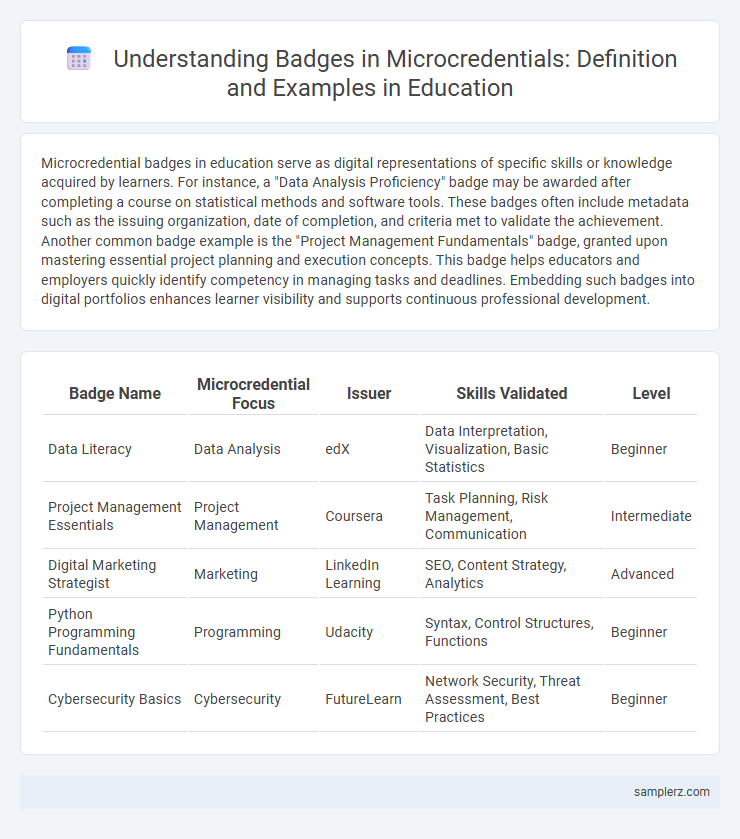Microcredential badges in education serve as digital representations of specific skills or knowledge acquired by learners. For instance, a "Data Analysis Proficiency" badge may be awarded after completing a course on statistical methods and software tools. These badges often include metadata such as the issuing organization, date of completion, and criteria met to validate the achievement. Another common badge example is the "Project Management Fundamentals" badge, granted upon mastering essential project planning and execution concepts. This badge helps educators and employers quickly identify competency in managing tasks and deadlines. Embedding such badges into digital portfolios enhances learner visibility and supports continuous professional development.
Table of Comparison
| Badge Name | Microcredential Focus | Issuer | Skills Validated | Level |
|---|---|---|---|---|
| Data Literacy | Data Analysis | edX | Data Interpretation, Visualization, Basic Statistics | Beginner |
| Project Management Essentials | Project Management | Coursera | Task Planning, Risk Management, Communication | Intermediate |
| Digital Marketing Strategist | Marketing | LinkedIn Learning | SEO, Content Strategy, Analytics | Advanced |
| Python Programming Fundamentals | Programming | Udacity | Syntax, Control Structures, Functions | Beginner |
| Cybersecurity Basics | Cybersecurity | FutureLearn | Network Security, Threat Assessment, Best Practices | Beginner |
Digital Badges: Defining Microcredentials in Education
Digital badges serve as visual representations of microcredentials, showcasing learners' specific skills, achievements, or competencies in education. These badges are embedded with metadata that verifies the credentials' issuer, criteria, and evidence, enhancing credibility and portability across platforms. Platforms like Credly and Badgr exemplify how digital badges facilitate lifelong learning recognition and skill validation in diverse educational contexts.
Popular Examples of Microcredential Badges
Popular examples of microcredential badges include Digital Marketing Certification, Data Science Fundamentals, and Project Management Professional (PMP) badges, each recognized for skill validation across industries. These badges typically feature metadata such as issuer details, competency descriptions, and evidence of assessment, enhancing their credibility and portability. Platforms like Credly and Badgr host these badges, enabling learners to showcase verified achievements on professional networks such as LinkedIn.
Skill-Based Badges for Student Achievement
Skill-based badges in microcredential programs often include digital credentials for competencies such as critical thinking, coding proficiency, and communication skills. These badges provide verifiable proof of student achievement that can be shared on professional networks like LinkedIn or included in digital portfolios. Recognized by employers and educational institutions, skill-based badges enhance students' career readiness by showcasing specific talents and practical abilities.
Industry-Recognized Microcredential Badges
Industry-recognized microcredential badges, such as IBM's Data Science Professional Certificate or Microsoft Azure Fundamentals Badge, validate specific skills and knowledge in high-demand sectors. These badges are issued by leading corporations and demonstrate verified competencies that enhance employability and career advancement. Earning such badges often involves completing targeted training modules assessed through practical exams or projects aligned with industry standards.
University-Endorsed Badge Programs
University-endorsed badge programs, such as the Digital Marketing Badge from the University of Illinois, provide learners with verifiable credentials that highlight specific skills and knowledge acquired through rigorous coursework. These badges leverage blockchain technology to ensure security and authenticity, making them highly valued by employers. By integrating industry-relevant skills with academic standards, university-issued badges bridge the gap between traditional education and workforce demands.
Technology Integration with Microcredential Badges
Microcredential badges in education often recognize proficiency in technology integration, such as demonstrating effective use of digital tools like Google Classroom, Microsoft Teams, or educational apps to enhance learning experiences. These badges validate skills in creating blended learning environments, utilizing interactive platforms, and implementing adaptive technologies to support diverse student needs. Earning a technology integration microcredential badge signals a teacher's commitment to innovative instructional strategies and ongoing professional development in educational technology.
Soft Skills Badges in Modern Education
Soft Skills Badges in modern education exemplify microcredentials that recognize abilities such as communication, teamwork, and problem-solving. These digital badges validate learners' interpersonal and leadership skills, enhancing employability and lifelong learning. Institutions increasingly adopt these badges to complement technical knowledge with essential soft skills in a competitive job market.
Professional Development through Badges
Professional Development through badges in micro-credentialing offers targeted skill recognition, such as Project Management Professional (PMP) badges that validate expertise in managing complex projects. These digital credentials enhance career advancement by showcasing verified competencies in specialized areas like instructional design or data analytics. Organizations and educators utilize badges to motivate continuous learning and provide clear milestones in professional growth pathways.
Assessment Methods for Microcredential Badges
Assessment methods for microcredential badges often include project-based evaluations, peer reviews, and competency exams that directly measure skill mastery. Digital portfolios and real-time feedback mechanisms provide evidence of practical application and learner progress. These approaches ensure microcredentials reflect verified competencies aligned with industry standards.
Future Trends in Educational Microcredential Badges
Educational microcredential badges are increasingly incorporating blockchain technology to ensure secure and verifiable credentialing. Platforms like Credly and Badgr are adopting AI-driven analytics to personalize learning pathways and validate skills in emerging fields such as AI, data science, and cybersecurity. These future trends highlight a shift toward more dynamic, interoperable badges that enhance lifelong learning and employability in a rapidly evolving job market.

example of badge in microcredential Infographic
 samplerz.com
samplerz.com